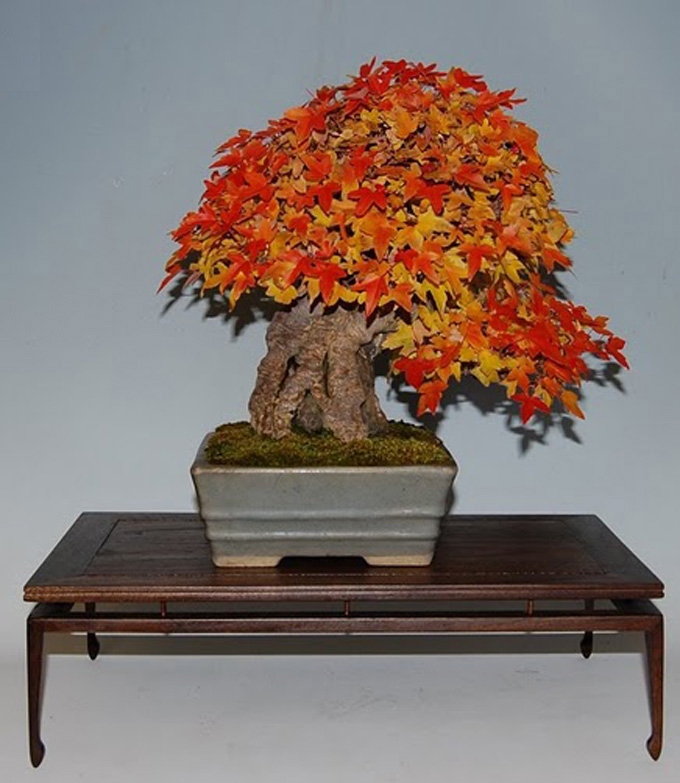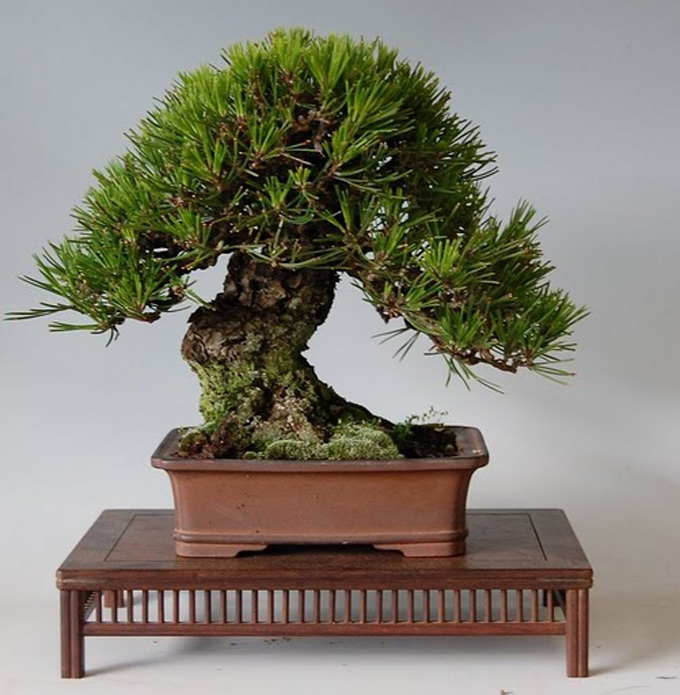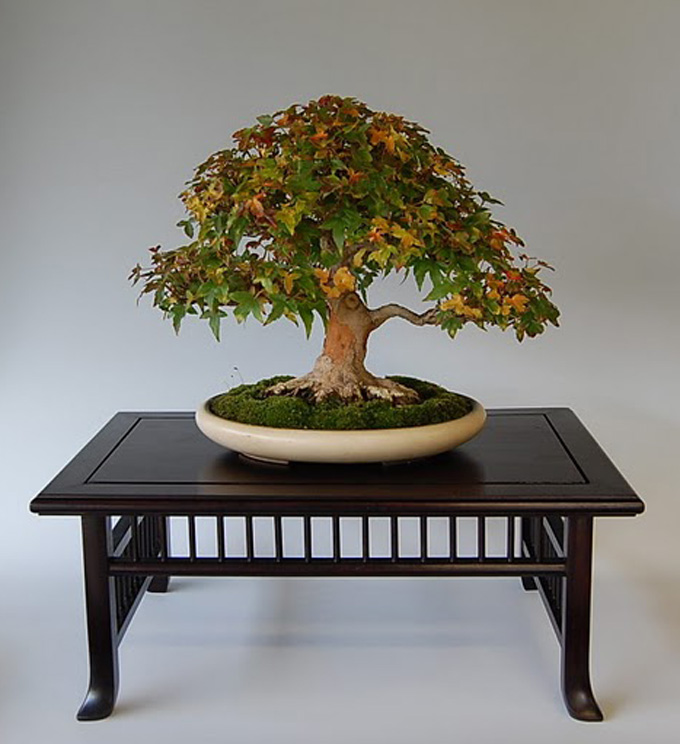 Root-over-rock Trident maple from Kaede Bonsai-en. In this case, it might be more accurate to say rock-almost-completely-swallowed-by-roots (which have morphed into a trunk). There are several things that stand out about this tree, not the least of which is the near perfect mix of reds, oranges and golds that make for a striking fall color display. Then there’s the trunk (ex-roots) with its impressive character and substantial girth relative to the pot and canopy size. Such thick trunks for such small trees are almost always the result of reducing trees that were grown in much larger containers (or in the ground); one of the most important secrets to impressive shohin bonsai.
Root-over-rock Trident maple from Kaede Bonsai-en. In this case, it might be more accurate to say rock-almost-completely-swallowed-by-roots (which have morphed into a trunk). There are several things that stand out about this tree, not the least of which is the near perfect mix of reds, oranges and golds that make for a striking fall color display. Then there’s the trunk (ex-roots) with its impressive character and substantial girth relative to the pot and canopy size. Such thick trunks for such small trees are almost always the result of reducing trees that were grown in much larger containers (or in the ground); one of the most important secrets to impressive shohin bonsai.
Shohin and nebari. It occurs that we often use words that may be Greek (or Japanese) to our less-initiated readers. A couple of these words that appear in this post are: shohin and nebari.
To quote Morten Albek, author of Shohin Bonsai, Majesty in Minature, “Shohin is the Japanese word for a tiny thing. Though not all shohin bonsai are tiny, they are all small.” By small, Morten means less than 10″ (25cm) tall and though there may be some variation depending on factors other than height, we’ll leave it at that.
Nebari is the Japanese words for surface roots (the visible tops of roots that spread out from the base of the trunk). A good nebari adds a sense of both age and stability to a bonsai. The last photo in this post shows an excellent nebari, especially for such a small tree (shohin).
The three photos in this post are all borrowed from Matthew Ouwinga’s Kaede Bonsai-en’s bonsai gallery. In addition to offering some of his tree’s for sale, Matthew also grows and sells seedlings.
 Shohin Mikawa Japanese black pine. Another trunk with impressive character and substantial girth relative to the pot and canopy size.
Shohin Mikawa Japanese black pine. Another trunk with impressive character and substantial girth relative to the pot and canopy size.
 Another Trident maple. Though the truck isn’t as massive as the other two trees shown here, still, it has plenty of character and enough girth to qualify it as a worthy shohin bonsai. Though what really catches the eye is the impressive nebari. Tridents and maples in general often have substantial nebari, still you seldom see one this well-developed on a shohin bonsai.
Another Trident maple. Though the truck isn’t as massive as the other two trees shown here, still, it has plenty of character and enough girth to qualify it as a worthy shohin bonsai. Though what really catches the eye is the impressive nebari. Tridents and maples in general often have substantial nebari, still you seldom see one this well-developed on a shohin bonsai.
Many years ago, I coined a term for bonsai that are short, but have a large girth at the base.
SUMO SHOHIN
Hi Mike,
Yes, Sumo. It works.
Thanks,
-w
Thanks for the definitions. It helps because these terms are used so much that for the un-informed it gets frustrating. Sharing knowledge is the greatest gift one can give.
Hi Joe,
Thanks for your feedback.
I’m thinking that maybe I’ll make it a habit to define terms more often. Help reduce that frustration.
-w
Hi Wayne… I’ve thought _nebari_ as referencing “root stretch” (as well as surface root distribution) including stretch up the trunk to where trunk girth (that dimension we use to approximate pot depth) should be measured. It includes surface root spread & expectation of the weight of a leaning trunk compressing roots in an acute angle under its lean & stretching roots (upward on the trunk) opposite its lean. If that is wrong (and it well might be wrong), I hope you or another browser will clarify. Nebari might not be easily replaceable by an English term; _kokejun_ [“taper”] & _tashiagari_ [“initial rise (to the first branch)”] are closely related. Does a tree with poor taper exhibit “good _nebari_” because it has well spread roots over the soil? Thanks for your advice.
Hi Chris,
Good comments, though I’m not so about the stretch and lean part (maybe someone can help clarify this). I do think that stabilizing surface roots opposite the lean on slanting bonsai are nebari, for sure.
I also think that nebari does include the swelling at the base of the trunk when there are surface roots present and that this contributes to taper. Beyond that, maybe someone more knowledgeable than I can shed some light.
I agree with Chris Cochrane. Nebari should not be only he root spread but the sum total of the root spread (flare would be better) combined with the tapering rise to the first branch and the angle or inclination of the trunk while it rises from the roots (giving the style definition). I think I have read an article in an old bonsai magazine which explained the angling of the roots & their flaring peculiar to the and dependant on the style of the bonsai.
Thanks Rajeev
I like the part about the relationship between nebari and tree style and have seen some writings to that effect in Bonsai Today and elsewhere